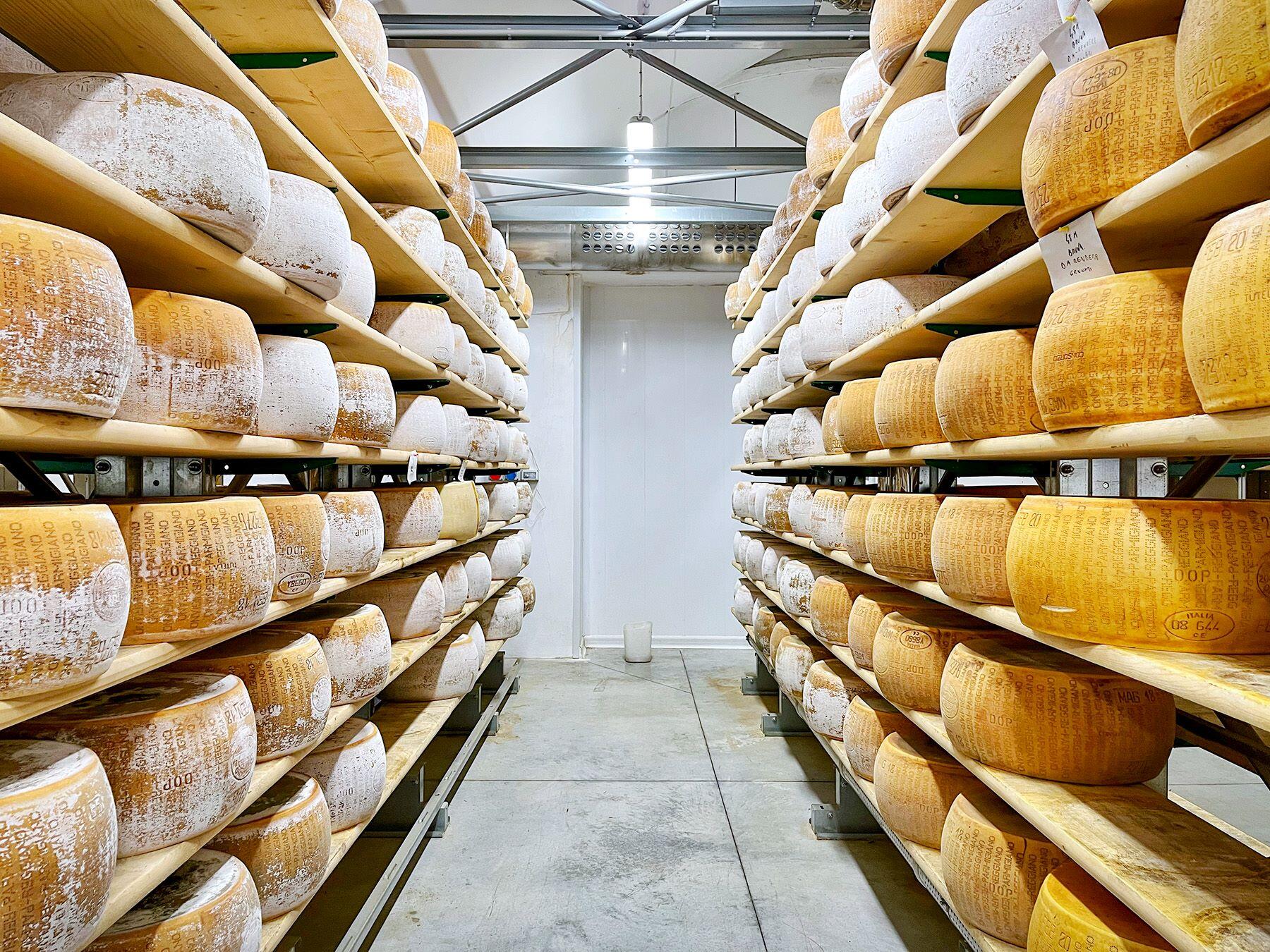The Parmesan commonly sold in the U.S. is merely a cheap imitation of the beloved Italian cheese.
If you’ve ever bought parmesan in the U.S. and compared it with real Parmigiano Reggiano made in Italy, you might have been shocked at how staggeringly different these two products are. Real Parmigiano Reggiano has a rich, subtly nutty taste and a grainy, almost crumbly texture when you cut it. Next to the real stuff, mass-produced parmesan is like rubber. Even Grana Padano—sometimes used as a substitute for Parmigiano Reggiano—pales in comparison.
Parmigiano Reggiano is a product with a Protected Designation of Origin (PDO), which means that there are strict regulations in place dictating exactly where and how it can be made. First and foremost, it can only be produced in five provinces in the Emilia Romagna region of Italy: Parma, Modena, Reggio Emilia, Mantua to the right of the Po River, and Bologna to the left of the Reno River. From the milking of the cows to the packaging of the cheese, every aspect of the production process must take place within these designated provinces.
Furthermore, the cheese must be made using a fully natural process without any additives. As the cheese matures, there are several quality controls. That’s why when the final product ends up in stores, it’s more expensive than other cheeses. In Rome, Parmigiano Reggiano typically costs around €15-20 per kilo in supermarkets. Considering the cost of shipping and importation tax, Americans can expect to pay even more.
Recommended Fodor’s Video

In Italy, Parmigiano Reggiano is ubiquitous. Chunks are cut off a wheel and eaten as a snack; it’s grated and put on pasta or risotto, or melted to make creamy sauces. In fact, Italians love the famous cheese so much that they only export 45% of the roughly 4 million wheels of Parmigiano Reggiano produced annually under the PDO to the rest of the world and keep 55% for themselves.
But nefarious cheesemakers around the world who want to capitalize off the success of Parmigiano Reggiano desperately try to pass off their second-rate, industrially produced products full of additives as Parmesan, hoping to fool naïve consumers. The Parmigiano Reggiano Consortium was created in 1934 for the purpose of protecting, defending, and promoting the product—and they estimate that fake parmesan constitutes a mind-boggling $2 billion market. All that fake cheese being sold is damaging the reputation of real Parmigiano Reggiano, which can’t be replicated elsewhere.
In 2008, the European Court of Justice of the European Union ruled that within the E.U., the word “Parmesan” can only be used to denote authentic Parmigiano Reggiano, but in the U.S. and other countries, there’s no such protection in place. It’s a battle that the Consortium is continuously fighting, with recent court cases in Colombia and Singapore ruling that Parmesan can’t be used to advertise products that aren’t made in Parmigiano Reggiano’s area of origin. Just last month, German authorities confiscated an American grated cheese labeled as Parmesan at a trade fair in Cologne, and the Cologne court issued an injunction banning the producer from advertising his product as Parmesan in Germany.
As an American living in Rome—and married to an Italian—I use Parmigiano Reggiano all the time, but I have to admit that I didn’t know much about how it’s actually made and what the Parmigiano Reggiano Consortium is doing to protect its reputation around the world. Curious to learn more, I traveled to Parma to get a behind-the-scenes look at the production process and speak with experts, including some of the cheesemakers themselves. What I learned opened my eyes to the world of Italy’s most beloved cheese and the enchanting region where it’s made.

Fittingly, the trip started with a vertical tasting of different ages of Parmigiano Reggiano. After a bit of time to rest after my journey on the train, I met up with a couple of representatives from the Parmigiano Reggiano Consortium and sampled Parmigiano Reggiano aged 12, 24, and 30 months. I had never really considered the age of the cheese I was buying at the supermarket, but tasting them side by side gave me a new appreciation for the more mature versions of the cheese. It turns out that 12-month-old Parmigiano Reggiano is best for snacking, but when grating it and putting it on pasta, it’s best to use a cheese that’s been aged a minimum of 24 months.
The next day started early. After a quick cappuccino, I was out the door at 7:30 and on my way to the Caseificio Montecoppe, a family-run dairy in the countryside outside of Parma. I made it there around 8 a.m., just in time to see the cheesemakers working the morning’s fresh milk into curds by combining it with fermented whey and rennet in giant copper vats. As the milk is heated to around 130 degrees Fahrenheit, the cheesemaker uses a special tool that looks kind of like a giant whisk on a long wooden handle to break up the curds that start to form, which sink to the bottom and form a single mass. After about fifty minutes, the cheesemaker separates the mass of curds from the whey using a large wooden paddle. Two cheesemakers work together to put the mass of curds into a giant linen cheesecloth and tie the ends to a metal bar draped across the vat. They then divide the mass into two and transfer each one to large round molds.
This is when the cheesemaker begins taking steps against counterfeiting. Inside the mold, there’s a casein plate with a specific pattern of dots that creates distinctive markings on the rind. Those dots form a sequential alphanumeric code that can be read like Morse code and used by the consortium to authenticate the cheese. The consortium also started putting food-safe microchips onto all the wheels of cheese so they could track exactly when and where they were produced. A special marking band then engraves the month and year of production onto the wheel of cheese, in addition to its factory registration number. After a couple of days in the forms, the wheels of cheese are immersed in a saltwater bath for 19 days. The cheese absorbs the salt by osmosis and loses four percent of its weight. At that point, it’s ready for maturation.

After visiting the maturation room and learning how the wheels of Parmigiano get tested by a member of the consortium for defects, I did another tasting and then visited the on-site shop. Then it was time to take a cooking class at Parma Rotta, a family-run restaurant serving the traditional cuisine of Emilia Romagna. Over the course of the next couple of days, I visited Podere Cadassa to learn how Culatello di Zibello (an artisanal cured meat similar to prosciutto) is made, went to Modena, and saw how traditional balsamic vinegar (another widely copied product) is made at the Acetaia di Giorgio, and ate my weight in pasta and Parmigiano Reggiano.
Before I left, I stopped by La Prosciutteria to buy Culatello, salame di Felino, and fresh pasta. But aside from bringing home a kilo of Parmigiano and a host of other food products, I brought home something even more important—a better understanding of the cheese I use on a near-daily basis. And that is priceless.




